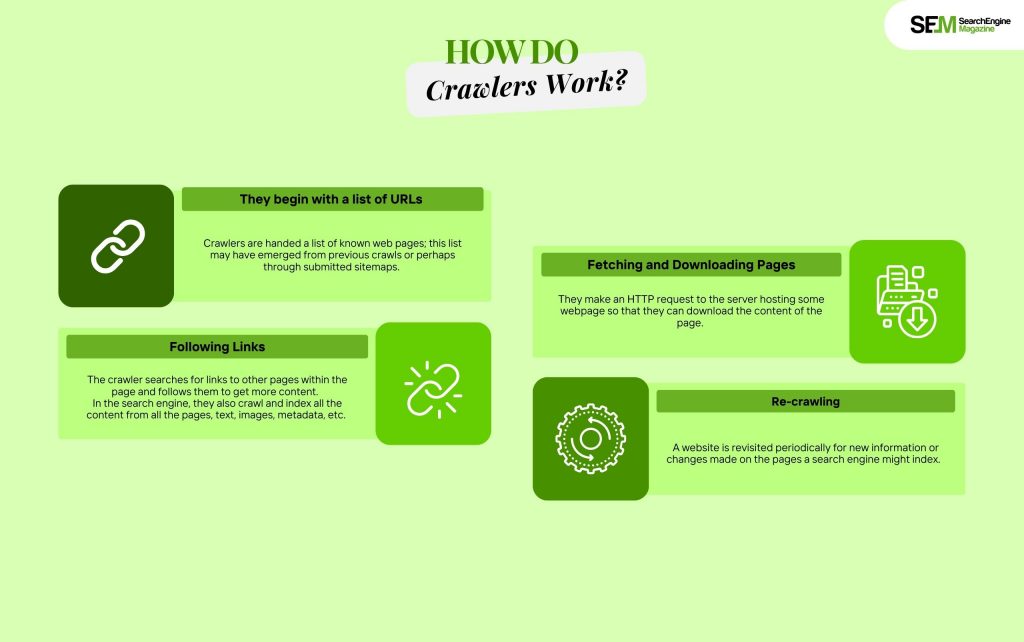How To Know If Someone Blocked You On iMessage? 5 Secret Hacks!
Apr 16, 2025

Apr 16, 2025

Apr 16, 2025

Apr 15, 2025

Apr 11, 2025

Apr 11, 2025

Apr 11, 2025

Apr 08, 2025

Mar 29, 2025
Sorry, but nothing matched your search "". Please try again with some different keywords.


Website crawling is how a search engine, like Google, uses automatic bots known as crawlers or spiders to crawl and index web pages.
It simply means crawlers scan the internet by hopping from one page to another via links, gathering data on every page’s content, structure, and relevance.
The data gathered is then indexed in the search engine; thus, when a user types a set of keywords, the site will be included in the results list.

Crawlers function by following a systematic process of discovery. Here’s how it goes about things:
Crawlers are handed a list of known web pages; this list may have emerged from previous crawls or through submitted sitemaps.
They make an HTTP request to the server hosting some webpage so that they can download the content of the page.
The crawler searches for links to other pages within the page and follows them to get more content.
In the search engine, they also crawl and index all the content from all the pages, text, images, metadata, etc.
A website is revisited periodically for new information or changes made on the pages a search engine might index.
Website crawling is vital in SEO because the search engine can understand and rank your site through it. If crawlers were not there, search engines could not index your content, making them invisible in search results. Here’s why crawling matters:
It also helps make your website appear in the search engine results pages, meaning your pages get chances to rank and appear in applicable search results.
Fresh content indexation occurs where frequent crawl ensures any new or up-to-date content on a site is rapidly added into the search engine indices from your pages, which remain relevant and up to date.
If spiders can crawl your site’s pages and understand your content, they will likely improve for specific keywords.

Here’s a list of factors associated with how a spider will be able to gain entry to crawl into and upon your site:
Where your website is well structured, the crawlers will be able to know which part to crawl and find out its contents.
This can be used as instructions by crawlers on which pages or parts of your site are acceptable or not allowed for crawling. Wrong settings might leave your crucial pages without indexes.
An updated XML sitemap helps the crawlers find and prioritize your most important pages.
Slow sites may hinder crawlers from effectively indexing your site because they can only access some of the contents over a reasonable period.
Broken link pages make crawling inefficient because these crawlers are likely stuck and unable to access subsequent pages.
When your content is embedded behind JavaScript, Flash, or other non-crawler-friendly technologies the search engine can have problems reading and indexing it.

Here are a few optimization tips to make sure search engines can efficiently index your website to rank well:
Submit an XML sitemap to search engines like Google through Google Search Console. This makes it easy for crawlers to find your website’s important pages.
Ensure your robots.txt file is not blocking crawlers from important pages that need to be indexed.
Optimize images, minify JavaScript and CSS, and caching methods. Making pages load faster is advantageous for both users and crawlers.
Try to identify broken links or 404 errors and then try to fix them. Crawlers can easily follow the links on your website.
Use a well-planned internal linking structure so the crawlers can easily follow through your site and index your pages accordingly.
As search engines do mobile-first indexing, ensure your website is mobile-friendly so the crawlers can easily access and rank your content correctly.
Crawlers can now read most scripts of JavaScript, though some older crawlers have not mastered it. Avoid strong reliance on JavaScript or Flash when such content is essential, and navigation is needed.

There are many tools available to track how well search engines are crawling your site and to make changes.
This single free tool by Google would let you know how Googlebot crawls your site and what problems as a problem, such as sitemap submission.
Ahref has a technical SEO audit tool from where you can view which problem crawlability issue has more than it would hinder the indexing of your webpage.
It is a website crawler showing how search engines crawl your website in terms of broken link redirects and even metadata analysis.
SEMrush has crawl errors, duplicate content, along with many other issues that prevent or affect your website’s site.
It’s an entire website crawler that gives you great insight into crawlability and areas that need improvement.
Website Crawling is the basic process of allowing Search Engines to index content for users to find later.
The more accessible your website is to web crawlers, the higher the chance of ranking well in SERP’s. Structure, speed, and accessibility are the main factors determining how efficiently crawlers index your pages.
Optimizing your website for crawling includes using XML sitemaps, fixing broken links, and improving overall site performance.
Checking crawling performance at intervals using tools like Google Search Console and Ahrefs ensures your website is accessible to search engines and ready to perform at search rankings.
You May Like To Read This:
Nabamita Sinha loves to write about lifestyle and pop-culture. In her free time, she loves to watch movies and TV series and experiment with food. Her favorite niche topics are fashion, lifestyle, travel, and gossip content. Her style of writing is creative and quirky.
View all Posts
How To Know If Someone Blocked You On iMessag...
Apr 16, 2025
7 Website Design Mistakes That Are Hurting Yo...
Apr 16, 2025
Programmable Dynamic SEO for Location-Based P...
Apr 15, 2025
Google Boba Game: How To Play This Fun Game B...
Apr 11, 2025
Which Is The Best Video Search Engine Of 2025...
Apr 11, 2025

